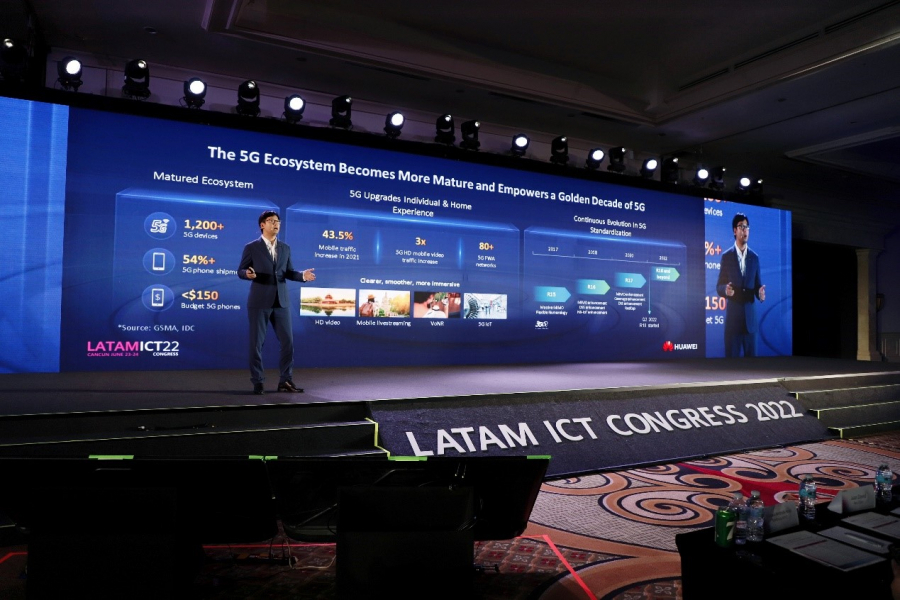Huawei is committed to bringing multi-antenna and ultra-wideband technologies to every frequency band and every scenario through continuous 5G innovation, to build a simplified, high bandwidth availability target network with universal coverage, thus ushering in a golden decade of 5G in Latin America", he said.
The development of 5G is accelerating in Latin America. In the last two years, 5G has been deployed commercially in countries such as Brazil, Mexico, Chile, and Peru. While launching 5G packages and enjoying the digital dividends, operators are actively exploring new services for consumers, families, and industries. Latin America is living a golden era of rapid 5G development.
After more than two years of practice in commercial 5G deployment, ultra-wideband and multi-antenna technologies stand out and become the first choice of most operators. "The spectrum
TDD spectrum with high bandwidth and high capacity has weaker coverage compared to low frequency bands, while FDD spectrum with wide coverage and fragmented frequency bands has low bandwidth", Fang said.
"As the pace of 5G spectrum distribution varies from country to country, 5G network construction faces different challenges posed by spectrum in different countries. However, the goal of 5G network construction is the same around the world, that is, to deploy a network in multiple TDD and FDD bands. Therefore, we constantly launch 5G product series to help operators address their challenges to build simplified and green networks that deliver an intergenerational experience".
Next-generation TDD ELAA-Massive MIMO enables optimal performance and energy efficiency.
It has become an industry consensus that Massive MIMO is the right choice for deployment with high-bandwidth continuous TDD bands. Huawei's latest MetaAAU features a new Extremely Large Antenna Array Architecture (ELAA), which doubles the array scale and improves uplink and downlink coverage without increasing transmit power, greatly enhancing the user experience. Tests show that, compared to conventional solutions, MetaAAU improves cell uplink and downlink coverage by 30% and the average cell edge user experience by 25%.
MetaAAUs enable base stations to achieve the same cell edge coverage with lower transmit power, reducing power consumption by approximately 30% compared to conventional AAUs.
"ELAA innovates in the new direction of improving coverage while reducing energy consumption. With the new architecture and algorithms, MetaAAU improves network performance and enables energy savings, helping operators build high-quality green 5G networks", said Fang.
FDD (massive 4T-8T-MIMO) ultrawideband multiple antenna solution maximizes spectrum value
Depending on the characteristics of FDD spectrum, multiple antenna and ultra-wideband technologies can be used to maximize spectrum value and enhance 4G and 5G experience and capacity when existing spectrums evolve to 5G.
Huawei has launched the industry's only highly integrated dual-band and ultra-wideband 4T4R RRU, which supports simplified deployment of 700-900 MHz/AWS + PCS multi-band networks.
Full-band dynamic power sharing and full RAT helps improve user experience by 20% and reduces power consumption by 20%. Huawei has also launched the industry's only ultra-wideband, ultra-high-power 8T8R RRU.
With support for AWS and PCS, and working with the first native 8T8R antenna based on the Hertz platform, it can significantly improve coverage and capacity.
In Latin America, where high-capacity antennas are restricted, Huawei will launch a new FDD BladeAAU next year. It integrates FDD Massive MIMO and full-band antennas to address deployment challenges.
For markets where new 5G bands have not been provisioned, multiple antenna and ultra-wideband technologies can be used to reduce deployment costs to upgrade existing sites, improve 4G experience and capacity, and support the evolution to 5G (including voice and IoT services).
Intelligent multi-band coordination (HashBAND) solution ensures optimal experience.
For future 5G networks where multiple FDD and TDD bands coexist, Huawei has developed the multi-band coordination solution - HashBAND.
It enables intelligent coordination between different 5G bands to expand 5G mid- and high-band coverage, while enhancing the low-band user experience at the cell edge, brings multi-band value to customer networks, and enables a better 5G user experience.
 English
English  Español
Español 
